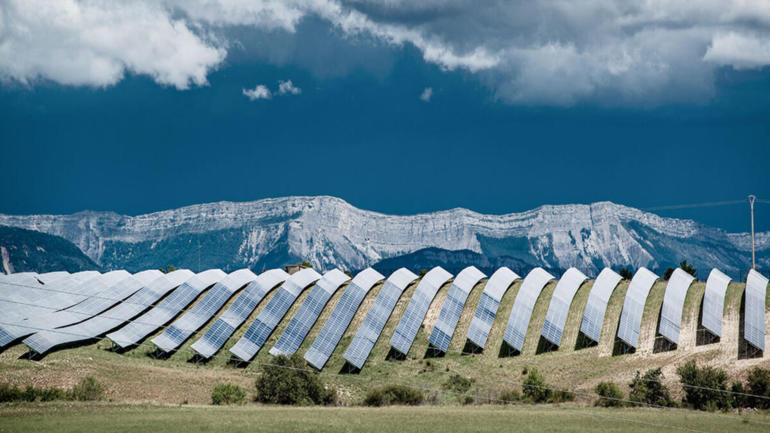Infrastructure plays an important role in achieving climate targets. The time is now to accelerate the deployment of electric infrastructure (e-infrastructure) and to increase the pace and impact of decarbonization at the nexus of the built environment, energy and transport. ”E-infrastructure” refers to a range of technical and structural interventions which enable electrification (e.g., EV charge points), energy efficiency (e.g., intelligent building management systems) and clean energy (e.g., distributed renewable energy such as solar PV arrays).
Companies and individuals across the globe are feeling the acute impacts of combined crises – the climate emergency, requiring aggressive decarbonization and the energy crisis, posing growing challenges on the supply side by affecting affordability, security and resilience. The urgent need for decarbonization is undeniable, and the demand side has a critical role to play in rapidly shifting to cleaner, more efficient operations of buildings, transport and energy.
Transport accounts for 37% of CO2 emissions from end‐use sectors globally, while buildings (including construction) account for nearly 15% of direct emissions – a share on the rise. In dense urban centers where transport largely happens via public transit or walking, buildings are often the greatest drivers of emissions. Regardless of the local context, the combined potential for these sectors to materially impact decarbonization is huge.
Regulatory shifts and consumer pressures are setting a pace for transition, but not a clear path to get there. We’re seeing progress in the mobility sphere, with the EU Council’s Fit for 55 package setting a target for all new cars and vans to be zero-emissions vehicles by 2035. For buildings, New York City’s Local Law 97 will enforce stringent emissions caps on buildings over 25,000 sq. ft. from 2024. In London, new policies set out that all major developments must conduct a whole life-cycle assessment as part of the planning process to minimize embodied and operational emissions.
Energy has historically been one of the first industries to embrace the change needed toward 1.5°C-aligned business models. For example, Energiewende, or “energy turnaround” in German, has been dictating the change in the German energy sector since the 2010s with a long-term goal to hit a renewable energy target of 60% by 2050. And just last year, the UK unveiled plans to decarbonize its national power grids until 2035 in line with ambitious countrywide 2050 net-zero targets.
Yet, despite the collective acknowledgment that rapid transformations are necessary, we still lack the scale required to achieve net zero across buildings, mobility and energy. On the supply side, economies of scale are yet to be realized, ensuring infrastructure coverage for accessibility, availability and affordability to serve diverse stakeholder needs. We will need to harness existing assets, including energy, buildings and fleets, to provide sufficient, flexible resources to enable the transition. Companies such as Eaton, a diversified power management company and technology provider, exemplify this approach through their ‘Everything as a Grid’ approach to support distributed energy resources.
On the demand side, wholesale behavioral change is required to transform the full value chain, from planning and procurement to end users’ behavior. As Vincent Minier, VP of Global Strategy Prospective & External Affairs at Schneider Electric, puts it: “Innovation will be driven by the demand side.”
No single sector can solve a challenge of this scale – integration between the built environment, energy and mobility is imperative, and legacy siloes must be overcome. Businesses need a collective approach to decarbonizing their buildings, fleets and energy systems to reduce operational emissions in the long-term meaningfully. This integrated approach helps embed the resilience and flexibility required for electrified futures while supporting reduced operational expenditure through increased efficiency.
We need pragmatic collaboration across sectors to drive this complex transformation. Over the past three months, the World Business Council for Sustainable Development (WBCSD) worked with some of its member companies across sectors to identify major bottlenecks in the deployment of e-infrastructure, distilling four key action areas that have to be addressed to accelerate decarbonization at the nexus of the built environment, transport and energy.
1. Value & transparency
Value and sustainability are not separate things - ultimately, decarbonization must be successful on the business fundamentals. As organizations weigh up the business case for decarbonization projects, they need to consider the longer-term outlook and the holistic impacts these projects can have on environmental, economic and societal outcomes. On the supply side, companies need to stay competitive while adoption catches up and the demand-side needs to future-proof business and build resilience.
Transparency through collaborative data-sharing is key to developing a view of the bigger picture. Accessible, quality data is vital to developing holistic business cases, helping organizations understand true value over longer time horizons. It is also a critical technological building block for truly integrated e-infrastructure.
2. Mobilization & skills
There are not enough professionals with the right skills, especially given the scale that must be covered. The International Renewable Energy Agency (IRENA) projects that the total number of energy sector jobs will reach 122 million globally by 2050 (compared to 58 million in 2017) on the 1.5°C pathway. We’re facing significant skills gaps not only for the installation and implementation of decarbonization technologies but also across the full breadth of supply- and demand-side organizations that will need to adopt and embed efficiency into their operational models. Future-proof organizations must break through internal siloes, building capacities, skills, mindsets and organizational structures to drive integrated action and implementation.
3. Financing & business models
The technology and financing is already there, but people don’t know how to close the gap between the two.
With energy prices soaring across all fuels, the financial case for many decarbonization technologies is becoming increasingly robust. According to the World Bank, energy prices increased by 1.3% in August, with coal up by 9.5% for coal and natural gas increased by a staggering 36.5% in Europe, compounding increasing pressure on other energy sources such as nuclear, hydroelectricity and wind power. Energy efficiency can bring near-term financial returns and payback periods for investments in decarbonization technologies are rapidly falling. For example, Carbon Brief suggests the payback period for a £4,300 rooftop solar system, with a power capacity of 3kW, has dropped from 16.7 years in October 2020 to a projected 4.1 years by April 2023.
Across the globe, significant investment is committed to decarbonization projects by the public and private sectors, yet financial barriers persist. There is a transformative opportunity to increase access to financing and optimize risk management with innovative targeted financing mechanisms, business models (e.g., as-a-Service models) and aggregation tools.
4. Advocacy & incentives
Government and public support can bring things forward by not necessarily providing the funds, but rather the right ecosystem.
Public-private collaborations are key to developing the highest impact blend of ‘carrot and stick’ measures. Enduring behavioral change for user acceptance and adoption requires tailored incentives, regulations and standards. Stable regulatory frameworks are pivotal to long-term investments. In some cases, governments are only positioned to act with the longer-term outlook required on the path to zero emissions, providing investment security such as underwriting offtake agreements.
WBCSD’s e-Infrastructure Accelerator
Complexity is inherent in the implementation of an integrated approach to decarbonization. To rise to this challenge, WBCSD has established the e-Infrastructure Accelerator. This cross-sectoral initiative aims to increase the pace and impact of decarbonization at the nexus of the built environment, energy and transport. It brings together WBCSD members and partners from both the supply- and demand-side across a range of industries to deliver on the vision of an integrated approach by enabling a collaborative community and co-creating practical tools.
Join us on 22 Sept for a webinar about the E-Infrastructure Accelerator, and hear more from organizations leading the way on the integrated energy transition. Register here.
If you are interested in our work on integrated approaches to decarbonization, please get in touch with Thomas Deloison.








